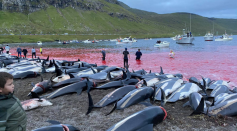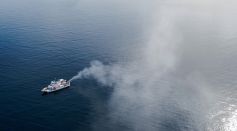ENVIRONMENT & CLIMATE
99 Million-Year-Old Fossil of Spider Mom Protecting Its Young Preserved Found in Amber
Sharks Caught in Commercial Fishing Die After Released Alive, Study Says

1,500 Dolphins Mass Slaughtered in Faroe Islands Could Spark Never-Ending Debate Over Danish Tradition Grindadráp

Dino-Killer Space Rock That Forms Chicxulub Crater Triggered the Evolution of Modern Snakes
European Green Crab Showed Extensive Dispersal Despite High Gene Flow, Low Genetic Diversity
World's Oldest Known Archaeological Site Candidates From 2.5 Million Years Ago, Make Giza Pyramids, Stonehenge Seem Young

Artificial Clouds That Can Cover The Great Barrier Reef from Extreme Heat Developed; How Does It Work?

Biodegradable Plastic Cutlery Developed to Transition Into Insulation Foams During Decomposition

Gold-Mantled Ground Squirrels Personalities Similar to Humans Like Being Shy, Social, or Bold That Is Beneficial for Ecosystem
Potty-Trained Cows: Scientists Get These Animals to Urinate in Specially-Constructed Toilet to Curb Greenhouse Emissions
Woolly Mammoth Back to Life: What George Church’s Colossal Intends to Happen Through CRISPR Gene-Editing System
Kuruma Shrimp Genome Provides Genetic Resource of Immune-Related Genes for Fisheries Management

Sunlight Exposure for 100 Hours or Less Melts Plastics, Breaks Them Down Into Smaller Soup of New Chemicals
6 Female Ocelots Returned to the Wild After Being Rescued From Wildlife Traffickers
Most Popular

Jeff Bezos' Vision of Millions Living in Space Nears Reality After Blue Origin Rocket Breakthrough

Hepatitis Types Explained: How to Recognize Hepatitis A, B & C Symptoms and Protect Your Liver

Microplastics Health Effects: Are Environmental Toxins and Plastic in the Bloodstream Dangerous?

3I/ATLAS: The Truth Behind the Mysterious Interstellar Object Now Targeted by NASA and UN Teams




